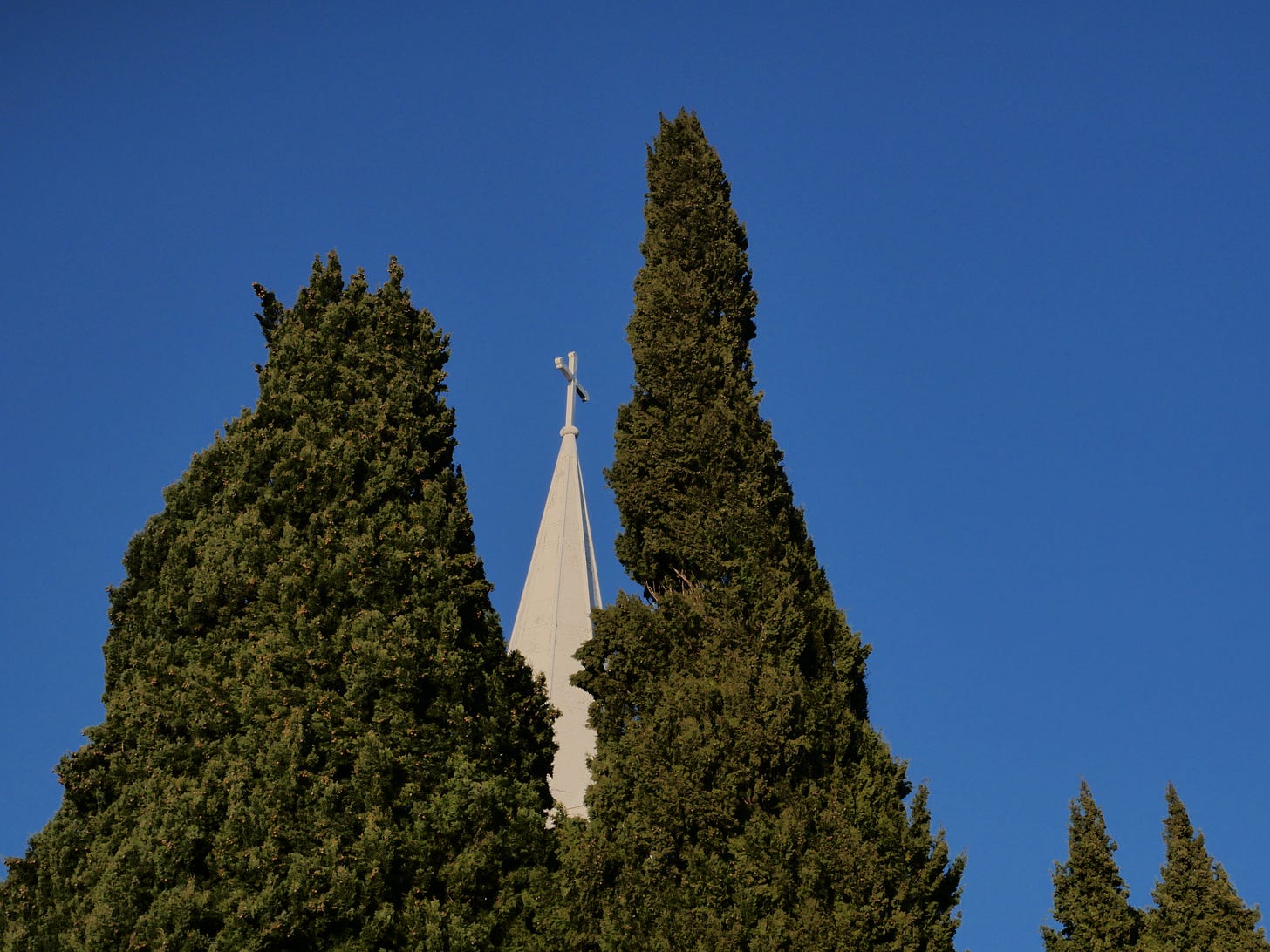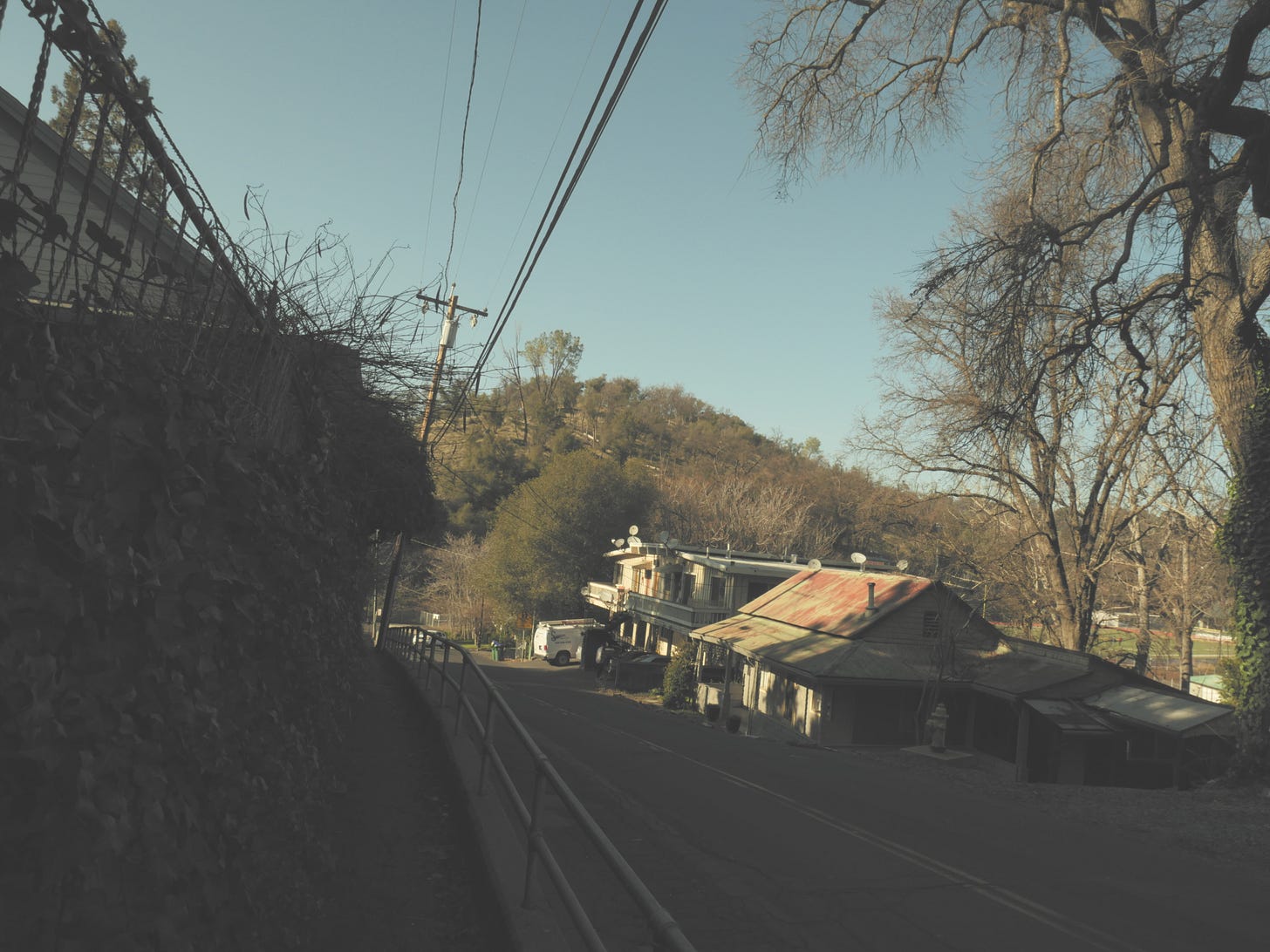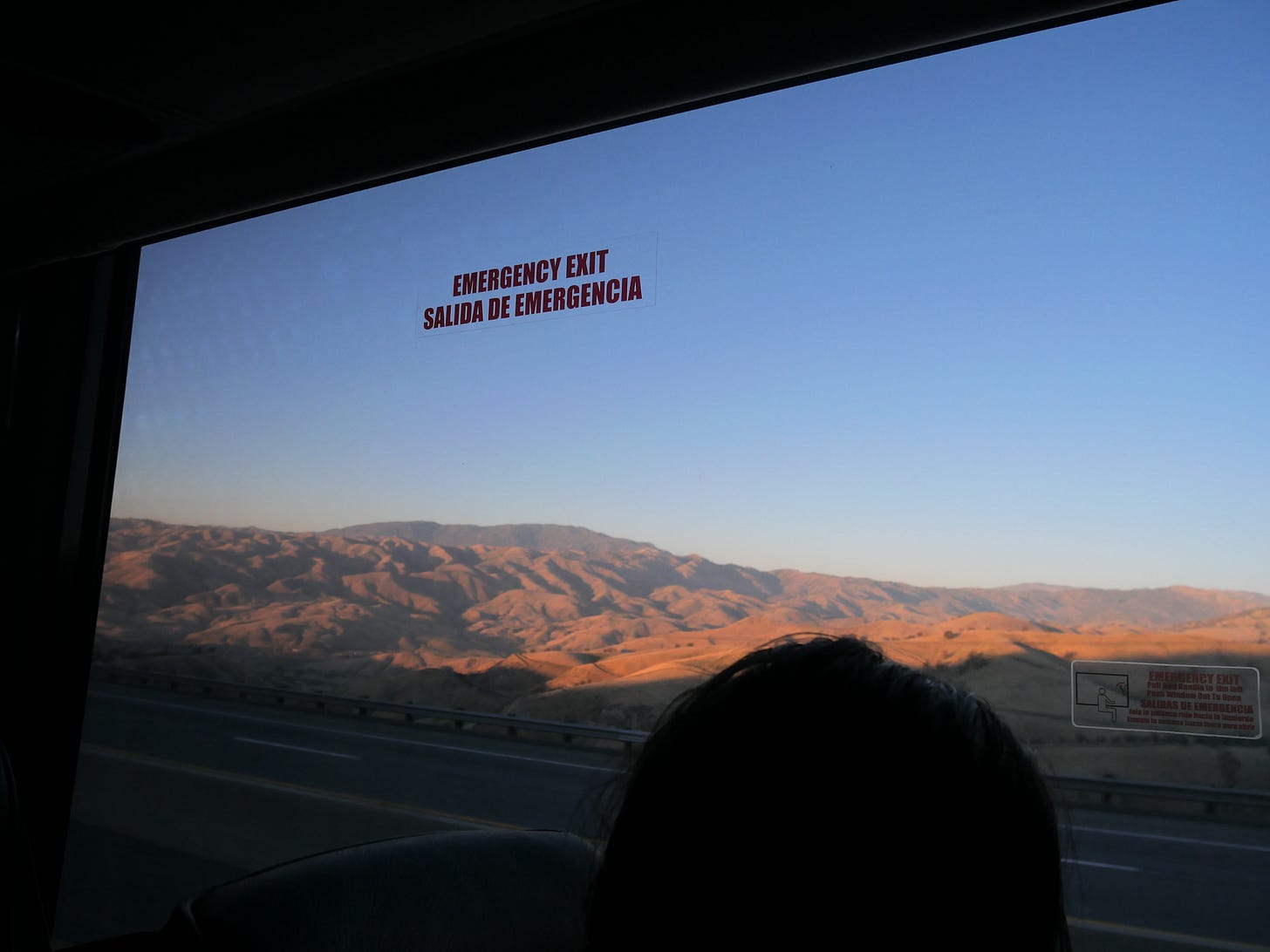The Pot of Gold at America’s Western Edge
I couldn’t help but think: ‘Why would anyone leave this fantastic place?’ even as we prepared to do so ourselves.
The boughs of the pomegranate bush clattered in the morning wind, branches drooping with heavy, frost-bruised fruits. The bush lilted her morning greeting to the rows of olive and grapefruit and palm, nodding to the yerba santa and the blue oaks. My own eyes seemed to be covered in a golden gauze as I rose to survey the variegated domain of fertile hills sprawling out before me. Everything was yellow with the spicy nicotine and ocher diamonds of the impossible California skies.
For those who have never been to California before, picture this: a heady sabbatical in Tuscany with Dr. Seuss. Everything in this westernmost state seems to ebb and flow in brief fits and starts through manicured vineyards, blossoming pastures, ranch roads, and hazardous gravel switchbacks slung high above dusty, half-filled reservoirs. It is America’s shimmering Eden, her promised land, the trophy of our young Republic that stands proudly as proof that every ounce of westerly motion was worth it.
To the pioneers, it was the end of the road. It was as far as a wagoneer could travel, cresting high over the infamous Donner Pass, if they had not yet succumbed to madness or scrofula, nor to hunger, smallpox, or cannibalism. Catching sight of the Pacific Ocean, the good earth bowed for the pioneers and did her curtsy. God Himself was the conductor of this symphony of holy life and sun-kissed valleys and endless deep-green ridgelines—and at the end of His great rhapsody, a frontiersman would build his fence lines and furrows and aqueducts.
In some sense, California is the mother of the very particular, feverishly intense, and unstoppable optimism that makes the United States what it is. All Americans are Californians at heart. We are, at our best, a fanatically optimistic sort of people—who might push for a half-year’s time across rough country just to see if the rumors of gold might be half true.
And in the case of California, the rumors were true: There was a pot of gold at the end of the rainbow. From the earliest “salad days” of these western farmers to the oil booms, the mining frenzies, the rise of Los Angeles and San Francisco, and later, the heady madness of Silicon Valley’s technological revolution. The incredible winnings of California’s early settlers course through the blood of Americans the whole country over, whether they have each seen California for themselves or not.
It all began the first moment that the pioneers caught sight of the poppies along the Sacramento River.
We crossed that river on a speeding train, with the desert well behind us and the pelicans flying above. Out the train window, the tall, slender cypresses stood like church spires, and below them, there were oranges and lemons, rice paddies and palms, hothouses bursting with lettuce and berries. A night train to Modesto followed.

Christmas came at a lovely older couple’s Central Valley estate. They were friends from Twitter we’d never met offline before, but they graciously took us in and treated us as if we were family. We stayed for a few days, picking our breakfast fruit from the citrus trees in the yard. The thick, humid, sun-warmed air hung along our skin like a blanket of youthful vapor. Everywhere on the streets of that city—whose incredibly apt motto is “Water, Wealth, Contentment, Health”—we were greeted as friends.
A cousin called from back East: five feet of snow, negative 15 degrees, a broken furnace—Merry Christmas. As he related this tale, I lazed beneath the lemon tree by the bougainvillea. I told him that it was 72 degrees where I was sitting; sun-drenched, in the fountain of youth. He grunted, and through the phone, I could hear him cracking open a noon-hour can of beer in the whipping winter wind.
I was born in California, at St. Mary Medical Center in Long Beach in 1994. The product of a Renaissance Faire romp between a traveling circus worker—my father—and my mother, who was a Navy Seaman stationed at Naval Weapons Station Seal Beach. Weeks before my birth, my father denied I was his child, and my mother tried to run him over with a car on the streets of Long Beach. He’d soon disappear in a drug-addled fugue, and would join the White Aryan Resistance, a Nazi skinhead gang. With a Nazi SS tattoo on his neck, he’d spend the next 30 years operating the Ferris wheel and the Tilt-A-Whirl with an itinerant crew of “carnies.” The affairs of the Aryan Resistance, traveling carnivals, and hard drugs would be at the center of his life for decades to come. Fatherhood, however, would not.
I wouldn’t even meet him until I reached the age of 30. He’d been in jail when I was born, and days later, I was removed to the East; far from California and the bad memories that lingered there for my mother and I.
Despite that, I’d make my way back to the Golden State many times in my early 20s. I’d hitchhiked up and down Highways 1 and 101 more times than I could count, and I was a two-time winter resident at “Slab City” a lawless shantytown full of squatters near the Salton Sea, between Palm Springs and Mexicali. There, I’d lived in a mud hut, subsisting on food I’d pulled from the dumpsters, camping in the sand with anarchist dropouts and drug-addled convicts.
I’d picked dates and oranges with the campesinos in El Centro, quaffed stolen liquor in dilapidated shacks in the high desert, brawled with junkies in a Mendocino beach town. In those years, I was overwhelmed by California’s many faces.
All that felt like a lifetime away as I awoke in an aging, creaky room in a Victorian hotel, high up in a village in the foothills of Yosemite in the first days of the New Year. The hotel porch lent us a vista of the strange landscape—sharply steep hillsides coated in moss and oaks; deep-red manzanita trees standing crooked in the orange dawn light. Below us on the street, the traffic was thick for a town of only 5,000 residents.
In the village quadrangle, ski bums waited for the bus to the mountains, sluggishly puffing torch-sized blunts; their ski boots sank into the moss-green mud in the park. And across the way, a Spanish Mission-type church stood tall above the village. I headed down to check out of the hotel. At the desk, a teenager sat, vaping profusely, telling me he’d come to California from Punjab, India, to become a millionaire.
“You know, big money—millionaire,” he told me. “I want to get into growing weed commercially. I want to be the Donald Trump of ganja.” As we walked out onto the street, he waved and smiled warmly, his blue eyes bloodshot, through a big cloud of smoke.
In one frame, California felt like Mexico; in another, Sicily—and in still another, it was a land of strip malls, condos, and ranchettes. The state is so large that it feels almost like multiple foreign countries melted together, with an American flavor whisked in. There are a thousand Californias, all pulsating minute by minute across this giant state.
Just as a teenager in the Central Valley rides his dirt bike along the earthworks by his family’s blooming walnut grove, a drug addict is picking aluminum fins off of unexploded bombs in the Imperial Valley’s Chocolate Mountain Aerial Gunnery Range to trade for meth. Meanwhile, a corporate meditation retreat takes place in the hills around Sonoma, while a Persian immigrant gets married at the courthouse in Rancho Cucamonga. An aging call-center worker sighs in an office in Anaheim, and a crew of Mexican cementeros pour a concrete shrine to the Virgin Mary on the side of the interstate in El Centro.
Soon, a farmer we’d met at a conference in New York, in the Catskills two months before, came to pick us up for a weeklong stay at his place.

As we rolled up the labyrinthine web of steep, twisty dirt roads, I saw that the pattern of settlement here was unlike any other rural region in the U.S. I’d ever seen.
Mini farms dotted the countryside; goat pens edged up to manicured, suburban-looking yards— dried-up aqueducts slashed across junkyard mountainsides and scraggly fields of brush where prizewinning bovines rambled and chewed. At the gas station, a dreadlocked yoga teacher kissed her roughneck cowboy boyfriend, but not before making him spit his chewing tobacco out into the sandy landscaping. Now, the sun was blazing a fierce heat in spite of dawn’s early chill, and the good farmer deposited us in front of a small cabin. In the distance, waggish goats brayed and tackled one another beneath the olive trees. We dropped our packs and felt awash in the bliss of this place.
We had not come to this place so much as we’d entered into it, for the map of California’s hilly regions is not two-dimensional.
From the warm, agricultural flatlands of the Central Valley to the hills, we delved upward layer by layer, being folded into a network of unmappable roads and pathways, down steep ravines, across seldom-seen valleys. Once we’d arrived at our destination, the ranch gate clicked shut behind our backs, enveloping us in a feeling of privacy so deep it feels like secrecy.
Strolling up to the farmhouse, I leaned over to the brawny, suntanned farmer: “You really seem to be living the most idyllic sort of life a human being could ever hope to live.” He beamed, nodding his head wordlessly. I couldn’t make out what he was actually thinking.
The Californian’s mode of expression can be a little hard to place; the Golden State’s people are smiley and warm—yet their hearts seem to be somehow hidden. It seemed to me that there is a certain sense of seclusion and privacy etched not only into the Californian’s land but also into his mind: a deep, impenetrable interiority that reclines behind hedgerows and palm trees and thickets of yerba santa and lemon. No matter where you go in California—from the ritzy beaches of Malibu to the rugged mountains of Humboldt County—this sense of privacy pervades.
For generations, it seems, residents of the Golden State’s hinterlands and foothills have instinctively sought to protect their impossible piece of paradise. Once the gamble has been won, a good fence and a long, unmarked driveway might be required to protect it.
But however idyllic a place this may be, experience had shown that it was simply not for me. I find the endless sunny days unnerving, and the price of real estate is appalling. Traffic-choked freeways, decade-long droughts, riots, earthquakes, wildfires—the many strange and unexpected drawbacks of the California lifestyle make for trouble in paradise.
Perhaps owing to these drawbacks, these days, the old route west to California seems to have been reversed. All across America, lifelong natives of the state to which the Okies—refugees from the Dust Bowl of the 1930s—once fled are fleeing again, this time eastward. From Vermont and Maine to Montana, Wyoming, Idaho, and Texas, it seems one finds another Californian has moved in each day, having left their home state due to a combination of astronomical home prices, far-left politics, and the abject decline of the quality of life in the large cities. As the recent wildfires in Los Angeles have shown, if none of the social, political, or economic factors drive certain Californians to leave—natural disasters often will.
Still, at that cabin on the farm in the high hills, no decline was remotely palpable. If anything, this place seemed every bit as heavenly as it must’ve in its earliest days of human settlement. I couldn’t help but think, Why would anyone leave this fantastic place?, even as we prepared to do so ourselves.

The farmer offered his point of view. “Just like America, Europe used to be a frontier, too. Eventually, the value of land settled out into something fairly static as the population increased. The real estate system went from being a free-for-all to an inheritance-based system,” he told me. “I think the same thing is happening with California; there’s only so much of it to go around.” He explained that he thinks California is transitioning from a “new world” settlement pattern to an old one. You can either afford land, inherit land, or you leave.
He was saying that there’s only so much gold in the pot at the end of the rainbow. No amount of optimism can increase the land area of California’s most desirable regions, from San Diego to Sacramento and beyond. While the moment one finds their gold is a mythically charged moment of delirious optimism and hope at day’s end, gold is still gold. It is scarce. Those who have it wish to hold it, and those who lack it will make their own voyages to head out and find it for themselves. And so it is that so many of the Golden State’s native sons depart from the land of ranch fences and palm beaches and holy hedgerows—to live out the story of their forebears again. To become “reverse Okies.” To find California, again.
Eastward to Arizona, the bus rocked along the Mojave Desert’s empty highways. Foggy, cream-colored cosmos spun overhead above the barbed wire and cacti. The Greyhound bus felt like one big, motorized covered wagon. America’s story hadn’t ended in California, after all. Here I was, catching a glimpse of its latter-day form.
Two men sat in the seat beside ours, chatting and sipping liquor out of a glass bottle jacketed in a paper bag. They were headed to Texas, driven out because they couldn’t afford homes in California, nor find jobs. “California part two,” one of them mused. “Fresh start.” They sounded like pioneers.
https://www.thefp.com/p/california-the-pot-of-gold?utm_campaign=email-post&r=rd3ao&utm_source=substack&utm_medium=email






Post a Comment